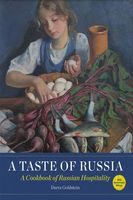Advertisement
Sitting Around the Samovar
Sweet Treats
Appears in
Published 1983
A house is beautiful not because of its walls, but because of its pies.
OLD RUSSIAN SAYING
Picture a brass urn with wooden handles, its high patina reflecting the warmth of a cozy room. The face of this urn, emblazoned with medals and etched with the likeness of the tsar, tapers down to an ornate spigot. This is the samovar, the symbol of Russian hospitality at its best.
In Russian samovar means “self-cooker.” Contrary to popular belief, tea itself is not made in the samovar; the samovar serves only to heat water and keep it hot. Nor is the samovar a strictly Russian discovery. The idea was first introduced by the invading Mongol hordes in the thirteenth century, hence the samovar’s exotic appearance and resemblance to the Mongolian hot pot. But tea-loving Russians found it too efficient to be ignored, and by the late eighteenth century the samovar had been adapted to everyday use and become an essential part of Russian life. It was always kept heated, ready to refresh guests with a cup of hot tea.

